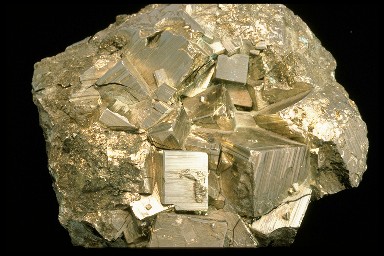Amethyst crystals from Brazil
Click on image for full size
Courtesy of Corel Photography
What Is a Mineral?
Minerals are the building blocks of rocks. They are non-living, solid, and, like all matter, are made of atoms of elements. There are many different types of minerals and each type is made of particular groups of atoms. The atoms are arranged in a network called a crystal lattice. The lattice of atoms is what gives a mineral its crystal shape.
Different types of minerals have different crystal shapes. Most minerals can grow into crystal shapes if they have enough space as they grow. But there are often so many different crystals growing in the same little area that they all compete for space and none of the crystals is able to grow very large.
There are two main ways that new crystals of minerals grow. Some minerals form when molten rock, called magma below a planet’s surface and lava above, cools and atoms bond together into mineral crystals. Other minerals form when water that has atoms of dissolved elements in it, evaporates away. The atoms get very close to each other and may bond together to form solid minerals.
The special shapes of minerals are not the only difference between them. Minerals can be identified by other physical properties as well. Each type of mineral has its own special characteristics.
Last modified January 24, 2008 by Lisa Gardiner.
You might also be interested in:

Everything you see around you is made of tiny particles called atoms. There are many different types of atoms, each with a special combination of protons , neutrons and electrons . These different types
...more
So far, over 2000 minerals have been found, and every year new ones are discovered. That's a lot of minerals! Don't worry! You don't need to know them all to be a rock hound. In fact, only a few dozen
...more
Magma consists of remelted material from Earth's crust and fresh material from other regions near the Earth's surface. When magma is erupted onto the surface in the form of lava, it becomes silicate rock.
...more
An element (also called a "chemical element") is a substance made up entirely of atoms having the same atomic number; that is, all of the atoms have the same number of protons. Hydrogen, helium, oxygen,
...more
Spotting minerals is fun! There are many different types of minerals, each with a different name and a special set of characteristics. So, if you find a mineral that you do not recognize, you can use
...more
Are you going out to search for rocks and minerals? How will you know what types you have found? Identification guidebooks for rocks and minerals can be very helpful. Pick one that has nice color pictures
...more
Differentiation is a scientific term which really means "to separate". In their earliest history, elements which made the planets would part into separate regions, if the planet were warm enough. This
...more














